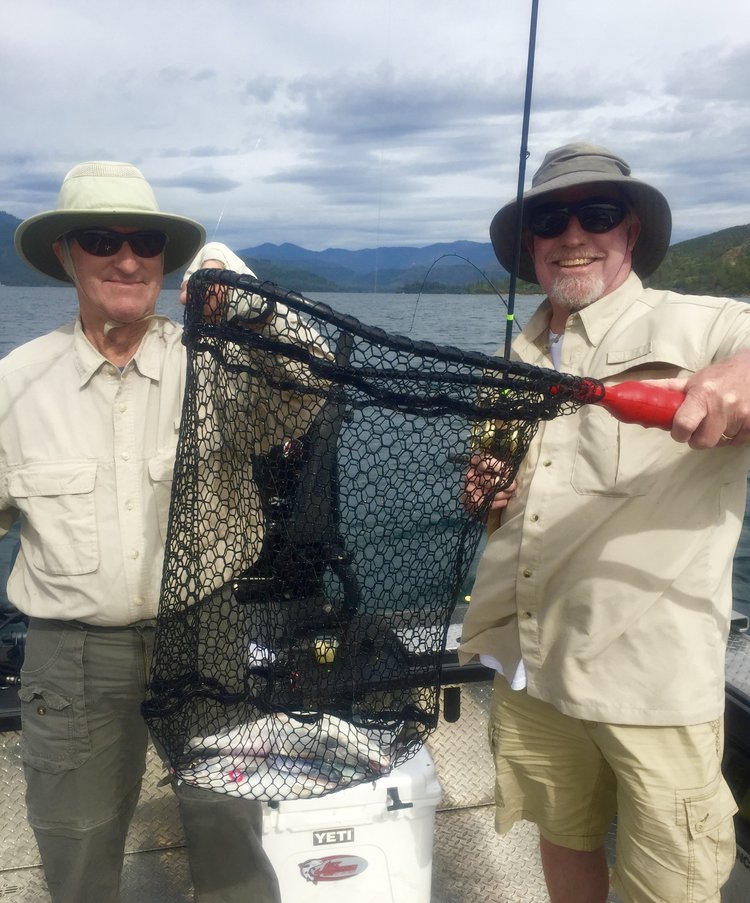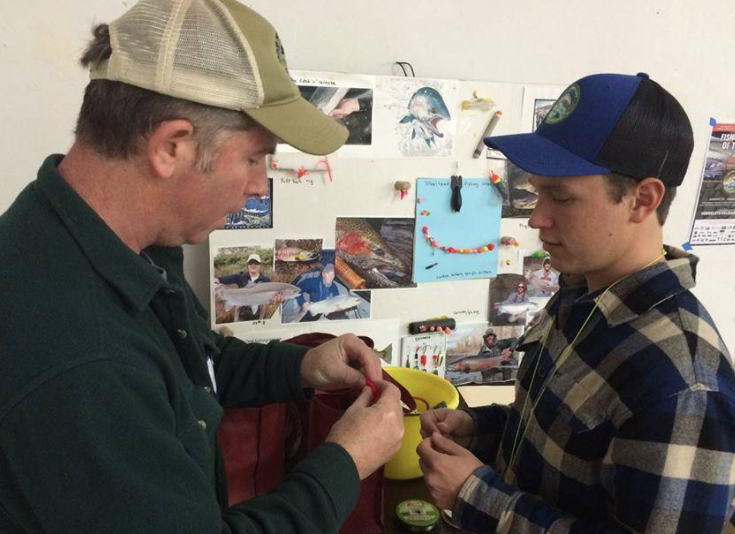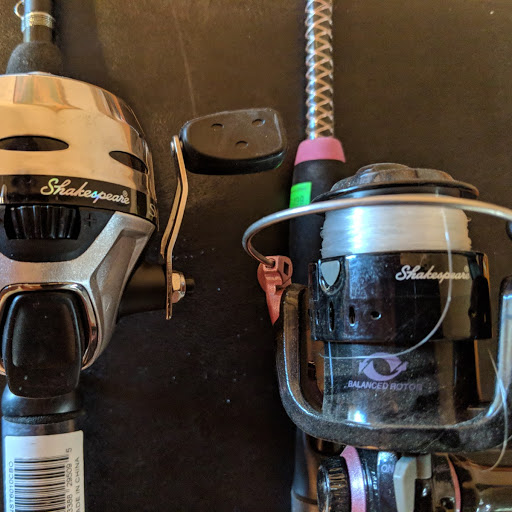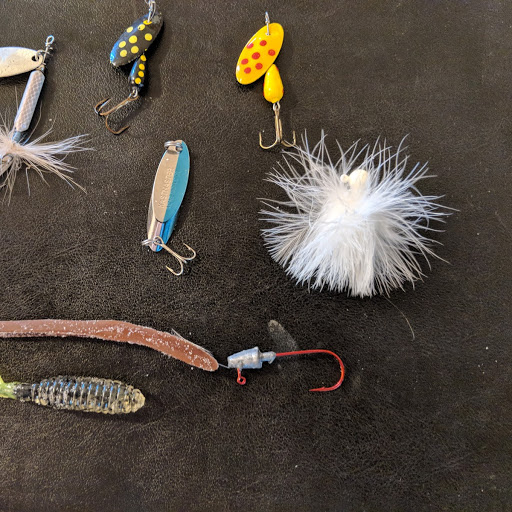Fishing Basics: Getting Started
by Gary Heffley
2-6-2018
Website
The first step in getting started is finding the necessities, The one-stop shop... the sporting goods store! It is the best place for everything you need, and clerks to assist so that you don't forget anything!
You'll first need a basic rod and reel selection. I recommend two types of red and reel combos for beginners. The rod and reels can be purchased separately, or as a matched combo package, often pre-loaded with matching line. For youngsters under 11 or 12, a size-appropriate spin-cast combo is very easy for youths to use. The push button reel (closed reel) allows for easy casting and keeps reel line tangles to a minimum. Teens and adults are better served with a 6' 6" - 7' medium spinning rod, with matching spinning reel spooled with 6 to 8 pound test monofilament. If your purchase is not a preset matched combo, make sure the rod and reel selected are balanced together. Too large a reel for a rod will see the rod feel bottom (butt) heavy, too light, and it will feel tip heavy. I cannot repeat this often enough, but if unsure of your purchase or selection, ask the store personnel for assistance. Another note is if you are spooling the line onto the reel yourself, do not overfill, as doing so will cause loops and tangles to develop when in use. And yes, the more expensive the set up, usually the better quality and overall performance, but a very good spinning combo can be purchased for under a hundred dollars.
There are a couple of basic bait setups and essential tackle needed that will cover most lake and stream fishing. The first setup is a simple hook and bobber that can be used with a variety of live baits such as worms, nightcrawlers, crickets and even minnows. Processed baits like salmon eggs also work well with this set up. Tackle needed will be size 6 and 8 snelled hooks, snap swivels, split shot and bobber. Note: Tie the snap swivel to the end of the line with a small split shot crimped onto the line about 12 inches above. The baited hook will hang below the snap swivel with the bobber placed on the line at the depth you wish to present the bait. Sometimes, the bobber is 6 to 8 feet above the hook, especially when fishing deeper water. Sometimes, 2 feet and less is all that is needed for shallow ponds. Some anglers will forego the bobber altogether to target fish in deeper water, letting the offering suspend off the bottom. Note: When using a bobber... if the bobber disappears under the water, reel any slack line quickly until pressure is felt and set the hook with a quick upward snap of the rod. If not using a bobber when the bite is felt by the rod tip bouncing up and down, set the hook in the same manner.
The other basic setup is for using baits that are made to float off the bottom, such as powerbait (doughbait), marshmallows (yes, mini marshmallows like you put in your hot cocoa) and inflated night crawlers. This is a very popular set up for trout anglers. Tackle needed is an egg sinker, snap or barrel swivel, and a small size 10 or 12 treble hook. There are some pre-tied treble hooks with a 24 to 36 inch leader that work great, but if just using a treble hook, some 4 pound test leader line is needed. Note: Slip the egg sinker onto the line from the rod before tying the snap or barrel swivel to the end of the line. Attach the leader with hook, or tie-on a 24 to 36 inch length of 4 pound line tothe swivel, tying the hook to the other end. The longer leader is designed to allow the bait to float above any bottom vegetation where trout like to cruise looking for food. The barrel swivel keeps the weight from sliding too far down the line keeping the bait at the proper depth. The trout will pick up the offering, and by using the sliding egg sinker, the trout will not feel any initial line pressure. As the tightening line and rod tip indicate the bite, reel up any slack line until pressure is felt, then set the hook with a quick upward snap of the rod.
A couple of tips when using marshmallows - add a piece of worm or salmon egg as an added attractor, trout love it. Also, many beginners make the mistake of using floating baits under a bobber. Don't do it, as the bait will just float towards the surface away from feeding fish. These baits are designed to fish just above the bottom in the manner described above.
There are a few basic lures that I recommend for trout, bass and sunfish. These can be tied to the end of the line and be used to cast and retrieve, allowing the angler the ability to cover a larger range of water than using bait. My personal favorites are a quarter ounce blue/chrome silver Kastmaster and quarter ounce red/white Daredevle spoons. While smaller sizes may be needed for smaller streams, the quarter ounce size allows for long casts. By varying the time the lure is allowed to sink before beginning the retrieve, it allows different depths to be targeted. Countdown the time before you begin to retrieve; if you get a strike, allow your next casts to sink that same time period, as you may have found a depth pattern or what is known as the “strike zone.”
Another couple of great lures to begin with are a silver, black or white Roostertail spinner, and either a black with yellow dots or yellow with red dots, Panther Martin spinner. Again, I like a quarter ounce size for cast-ability. It is best to connect the spinners to the line with the use of a small snap swivel as an aid to limit line twist. Again, a cast and retrieve works well in lakes and streams.
You may ask, why "those" colors, when there are so many to choose from. The idea is to match the forage food source of the fish. Red and white can represent crayfish or a bleeding injured fish. The silver blue combination spoon or white, black and silver spinners, represent a shad or other bait fish that predators feed on. While the black yellow combo may resemble a bumble bee, these color combinations have just produced over the years- especially in the Hat Creek region and other North State trout waters, hence my recommendations.
Another great basic lure is a small white crappie jig. Crappie and bluegill in ponds and lakes, as well as trout, love this simple presentation of the jig suspended under a bobber. Note: For crappie and bluegill, cast near tules or submerged vegetation and retrieve slowly.
A great basic easy-to-use bass lure is either a 4 to 6 inch plastic worm, or a 3 to 4 inch curly tail grub tied onto the line by a small dart head jig head, an eighth ounce to quarter ounce in size. Note: Thread the worm or grub onto the hook so that the body hangs straight below the hook. Being straight is very important. This setup can be fished many ways. A steady retrieve will produce a swimming action while allowing the bait to sink to the bottom, and slowly, (very slowly) lifting and reeling will allow the bait to hop along the bottom. Both techniques will produce pickups. Again, a quick upward snap of the rod tip is needed to set the hook when a bite is sensed. When purchasing, check with the local shop for color recommendations, although, a salt and pepper grub and oxblood worm are always goods colors to start with.
So, we have the rod, reel, line, a few basic setups for bait use, and some basic lures. Let's cover some other essential items for the tackle box...oh yeah, you will need one of those as well, a small one will do at first. The most important item to put into the box is a current set of fishing regulations. This will tell you if there are any tackle restrictions, size and take limits, and even if the body of water you want to fish is open to angling. Important Note: Read and familiarize yourself with the regs before you venture onto any new water. The North State has special seasons and regulations for many bodies of water and the fines and penalties are steep for violations.
A small pair of needle nose pliers serves a number of purposes; attaching split shot, trimming line, removing hooks from fish and even crimping barbs on hooks when needed. A small measuring tape is needed to make sure fish caught are within any applicable size limits. A small stringer to attach fish onto is valuable to keep fish fresh, unless you plan to practice catch and release. A knife to clean and fillet fish can always come in handy, and a small first aid kit, or at least a few band aids, and some sun screen are also great additions to your tackle box.
Other considerations would be; a net to help land the fish, an ice chest to carry home your catch, a camera to keep memories of the big one that didn't get away, and a hat and polarized sunglasses to help see fish and protect against the sun. And, if you're fishing from a boat, a PFD ( Coast Guard approved personal flotation device) is a must.
So, now all you need to get is a current fishing license if you are over the age of 16, and you are ready to venture out and catch some fish. But, remember to enjoy the experience, the natural surroundings and the camaraderie when fishing with others. Sometimes catching fish is just a bonus.
Here's a Basic checklist to successfully launch your fishing experience!
rod
reel
line 6 or 8 pound test
tackle box
fishing license and regulations
small to mid size bobbers
egg sinkers
split shot
snap swivels
barrel swivels
size 6 and 8 snelled hooks
size 10 or 12 treble hooks with 24 to 36 inch leader
4 pound leader line if leader not attached
silver/ blue Kastmaster spoon.....quarter ounce
red/white Daredevle spoon......quarter ounce
silver, white or black Roostertail spinner..... quarter ounce
black w/yellow dots or yellow w/ red dots Panther Martin spinner.... quarter ounce
white crappie jig
quarter ounce dart head jig hooks
4 inch curly tail grubs
4-6 inch straight tail worm
needle nose pliers
fillet knife
stringer
small measuring tape
small first aid kit and sunscreen
A great attitude and the desire to learn, enjoy and share the wonders of the sport of fishing.
Gary Heffley has been a valued contributor to MyOutdoorBuddy for over 10 years serving as manager, sales representative and reporter for much of Northern California. He is an avid outdoorsman and loves to fish and write about his adventures. He has a long history in the Sporting Goods field and uses that extensive experience to impart his wisdom in his writing.
Photos
More Reports
Whiskeytown Lake Kokanee bait
Whiskeytown Lake
2-2-2018
Winter in Northern California can be both beautiful and brutal depending on what kind of weather patterns Mother Nature sends...... Read More

2-2-2018
The 5th annual Humboldt Steelhead Days Expo When: Saturday, Feb. 3 • 11am to 3:30pm • FREE! Where: Prasch Hall Community Center is located on the Perigot Parks...... Read More


